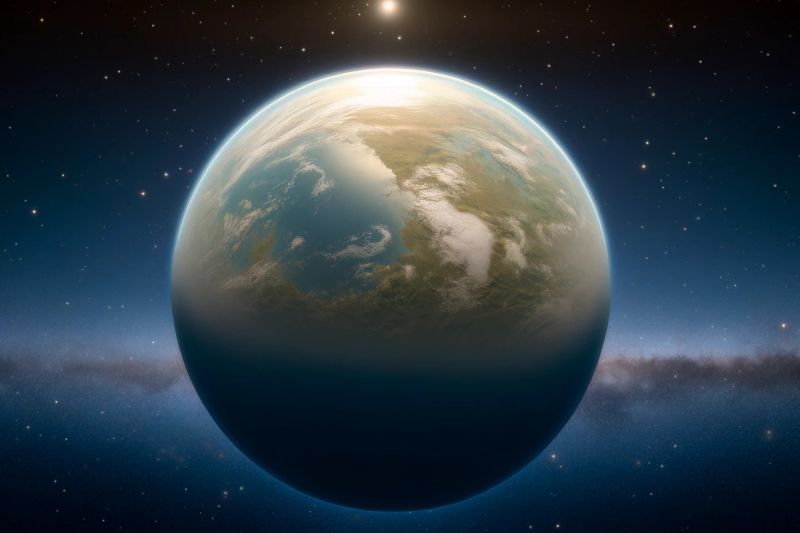
© image generated by DALL-E AI for Presse-Citron
For decades, cosmos specialists have been probing the confines of the Universe, tirelessly searching for worlds suitable for the emergence of extraterrestrial life. Previously, their attention was mainly focused on gas giants, much larger than our modest blue planet. However, a new study, the result of research carried out by the University of Rochester and recently published in the columns of the Planetary Science Journal, has shaken up this approach.
From now on, it would seem wise to focus our efforts on rocky stars of smaller size, but with natural satellites. Indeed, these celestial configurations could prove fundamental in the establishment and perpetuation of the conditions for the emergence of living things.
The moons, guarantors of habitability?
The influence of our natural satellite on the evolution of terrestrial life proves undeniable. Indeed, the Moon orchestrates the ballet of tides on the Earth's surface, contributes to climatic balance and modulates the rhythm of our days. Miki Nakajima, a researcher in environmental sciences at the University of Rochester, therefore puts forward this hypothesis: smaller stars would paradoxically be more conducive to hosting moons.
She specifies: “ Relatively small planets, of a size similar to that of the Earth, are more difficult to observe and n’ have not been the focus of the search for moons […] However, we believe that these planets are actually better candidates for hosting moons”. The scientist supports her point by explaining that space collisions generating large satellites occur more frequently around planets with reduced dimensions.
The theory of flow instability
The origin of our natural satellite has long sparked lively debates within the scientific community. The predominant hypothesis evokes a cosmic cataclysm that occurred some 4.5 billion years ago: the collision between the primitive Earth and a planetary embryo comparable to Mars. A titanic shock which would have projected into space a whirlwind of partially vaporized debris, which would then have agglomerated to give birth to the Moon.< /p>
The innovative work of Nakajima and his collaborators sheds new light on this theory by exploring the phenomenon of flow instability< /strong>. This mechanism causes particles in a gas disk to rapidly concentrate, creating planetesimals (the building blocks of planets) and smaller building blocks that can form satellites. This process is particularly effective in a vapor-saturated environment, such as that resulting from a colossal impact between two celestial bodies.
Nevertheless, Nakajima's team has highlighted a major constraint: within a dense, vapor-rich disk, the building blocks of emerging satellites experience considerable drag. This force is so intense that it hurls these nascent bodies toward the central planet before they can transform into true moons. Paradoxically, too violent an impact, generating a completely vaporized disk, would compromise the formation of massive satellites. Their study therefore suggests that a moderate impact would be more conducive to the birth of an imposing moon.The initial collision should be sufficiently “measured” to generate a partially, but not totally vaporized disk.
Thus, Nakajima's research reveals that the genesis of large moons depends not only on the presence of a debris disk, but also on its specific composition, itself dependent on the intensity of the original impact.
What implications for the search for exoplanets ?
To date, more than five thousand exoplanets have been listed by the astronomers (including the very promising Gliese 12 b). However, their natural satellites remain enigmatic, escaping our detection due to their reduced dimensions. Nakajima's innovative work highlights the relevance of focusing our research instead on smaller stars in our quest for potentially habitable worlds.
Future observations, carried out using instruments such as the James Webb telescope, could corroborate these hypotheses. Already, programs aim to exploit the capabilities of this space observatory to track exomoons orbiting planets similar to Earth or Jupiter .
These investigations could support the idea according to which modest stars with important satellites constitute cradles conducive to the hatching and flourishing of life. So size might finally matter!
- According to recent research, small rocky planets with moons are potentially better at supporting life than large gaseous planets.
- Our Moon plays an elementary role in the & #8217;balance of our planet, suggesting that large moons could thus be essential for life
- In the future, future observations with James Webb will will focus on the detection of these exomoons to confirm these hypotheses.
📍 To not miss any news from Presse-citron, follow us on Google News and WhatsApp.
[ ]

